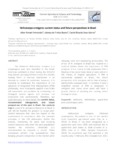Use este identificador para citar ou linkar para este item:
http://www.alice.cnptia.embrapa.br/alice/handle/doc/1016904Registro completo de metadados
| Campo DC | Valor | Idioma |
|---|---|---|
| dc.contributor.author | POMARI-FERNANDES, A. | pt_BR |
| dc.contributor.author | BUENO, A. de F. | pt_BR |
| dc.contributor.author | SOSA-GÓMEZ, D. R. | pt_BR |
| dc.date.accessioned | 2015-06-02T11:11:11Z | pt_BR |
| dc.date.available | 2015-06-02T11:11:11Z | pt_BR |
| dc.date.created | 2015-06-02 | pt_BR |
| dc.date.issued | 2015 | pt_BR |
| dc.identifier.citation | Current Agricultural Science and Technology, [Pelotas], v. 21, n. 1, p. 1-7, 2015. | pt_BR |
| dc.identifier.issn | 2317-2436 | pt_BR |
| dc.identifier.uri | http://www.alice.cnptia.embrapa.br/alice/handle/doc/1016904 | pt_BR |
| dc.description | The bollworm Helicoverpa armigera is a polyphagous pest first identified in the South American continent in Brazil during the 2012/13 crop season, worrying farmers across the country leading them to overuse insecticides in an attempt to control its outbreaks. However, it is essential to emphasize the importance of the adoption of Integrated Pest Management (IPM) philosophy, since improperly applied insecticides will exacerbate pest problem by eliminating the biological control agents and increase the production cost unnecessarily. Therefore, our work discusses, in more detail, the current status, recommended management, and future perspectives of this pest in Brazil. We conclude that, in spite of H. armigera infestation in Brazil, it will still be feasible for growers to adopt pestcontrol measures that have less impact on the environment in accordance with the standard principles of the IPM philosophy. Within this context, monitoring for pests and initiating control measures only when the pest populations reaches the economic thresholds (ET) recommended by research is crucial. These procedures protect crop sustainability, thus keeping growers competitive in the market while reducing costs and maximizing productivity. The arrival of H. armigera in Brazil has resulted in a national debate about the importance of IPM adoption. It is a chance to fully implement IPM in Brazil as it has never been done or seen before in the history of tropical agriculture. If IPM is successfully adopted in Brazil, the future perspective of H. armigera will be that of being a satisfactorily managed pest. In contrast, if only a simplified version of IPM is employed, H. armigera and many other pests will have a greater chance of surviving and causing severe damage to crops. | pt_BR |
| dc.language.iso | eng | eng |
| dc.rights | openAccess | eng |
| dc.title | Helicoverpa armigera: current status and future perspectives in Brazil. | pt_BR |
| dc.type | Artigo de periódico | pt_BR |
| dc.date.updated | 2017-07-31T11:11:11Z | pt_BR |
| dc.subject.thesagro | Lagarta | pt_BR |
| dc.subject.thesagro | Praga de planta | pt_BR |
| dc.subject.nalthesaurus | Insect larvae | pt_BR |
| dc.subject.nalthesaurus | Helicoverpa armigera | pt_BR |
| riaa.ainfo.id | 1016904 | pt_BR |
| riaa.ainfo.lastupdate | 2017-07-31 | pt_BR |
| dc.contributor.institution | ALINE POMARI-FERNANDES, IAPAR; ADENEY DE FREITAS BUENO, CNPSO; DANIEL RICARDO SOSA GOMEZ, CNPSO. | pt_BR |
| Aparece nas coleções: | Artigo em periódico indexado (CNPSO)  | |
Arquivos associados a este item:
| Arquivo | Descrição | Tamanho | Formato | |
|---|---|---|---|---|
| 4234184891PB.pdf | 495,93 kB | Adobe PDF |  Visualizar/Abrir |









